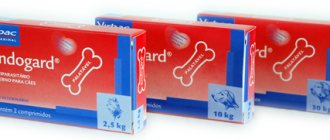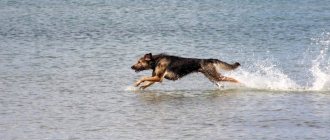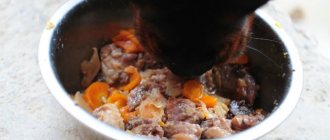January 27, 2016
People have different attitudes towards winter, which sometimes lasts unbearably long in our latitudes. Some try to get as much joy as possible from winter activities, others prefer to while away long evenings in a cozy chair and not stick their nose out into the street.
But be that as it may, if a dog lives next to you, then you have no right to deprive it of long winter walks. After all, our four-legged friends love winter very much and tolerate cold much better than heat.
Of course, winter in the city has its own characteristics that have to be taken into account. Now we’ll talk about how to walk your dog in winter so that walks bring you both only pleasure.
Choose the right clothes for a walk
Long-haired dogs tolerate cold weather more easily, so they do not need additional equipment. They need warm, waterproof overalls if the walk takes several hours. But owners of small breed dogs or dogs with short hair should take care of thick overalls, jackets, sweaters, hats and boots to protect the dog’s paws from reagents and salt. Breeds such as Toy Terriers, Chihuahuas and Chinese Cresteds begin to freeze even at slightly above-zero temperatures.
Age
As a rule, a puppy is taken from a breeder at the age of 2.5–3 months. This is the optimal time to start walking. True, it often coincides with the quarantine period of vaccinations, but even in this case it is recommended to take the puppy outside in your arms or in a carrier at least for a short time. Why is it important? Behavior problems associated with insufficient socialization are among the most common in canine practice. Interestingly, at the age of 2.5 months, the dog most often is not afraid of the street and calmly tolerates walks. But by 3 months the animal begins a period of fear. A dog can be frightened by cars, passers-by, other animals and loud noises. Therefore, the sooner small walks begin, the better. And winter should not disrupt these plans.
Can dogs wear shoes in winter?
If you have a short-haired dog, or a dog that does not have an undercoat, then it may freeze in winter. If there is severe frost outside, then your pet needs to be dressed in a winter jacket, or a sweater or other warm clothing. Be sure to wear winter boots on your dog, thanks to them, their paws will be protected from sharp ice, snow, and also the chemicals that are sprinkled on the streets. If the dog does not want to wear shoes, then at first wear them only for short periods of time, be sure to praise your dog, try to communicate with him more and increase the period of time that the dog wears the shoes. However, even if you choose the warmest jacket and boots, your dog will not be protected in very low temperatures.
Taking your dog for a walk: winter tips from veterinarians
Most dogs love winter: while the owner, wrapped in a warm scarf, waits patiently, the four-legged pet can frolic in the snowdrift tirelessly. But, like people, pets are susceptible to colds in winter. Therefore, a caring owner must take measures to protect the dog from hypothermia, even if the dog has thick hair and enjoys a walk in severe frost.
Domestic dogs spend most of their lives in an apartment, in comfortable temperature conditions. Therefore, even an outwardly “frost-resistant” pet may have lower immunity than that of a wild relative. To figure out how to properly walk your dog in winter and protect the health of your beloved pet, we turned to a family of veterinarians from St. Petersburg - Anna and Egor. On their Instagram page they share useful information about caring for pets.
— Depending on the dog’s temperament and breed characteristics, it is advisable to reduce the duration of walks during the cold period to 10–15 minutes. As a rule, at temperatures above –10
Obaks
can walk for a longer time, but if the thermometer drops lower, then even with high activity it is more difficult for them to retain heat.
This restriction does not apply to dogs with a good thick undercoat and a sufficient layer of fat (such as Malamute, Husky, Samoyed and other similar breeds or their crossbreeds). During the entire walk, you need to monitor your pet's behavior. If you notice that the dog begins to tremble, tucks its paws and wants to leave, it means that it is frozen. And it’s better to quickly go home or to any possible warm room (if you have gone far from home) to let your pet warm up.
Dogs with thin or absent undercoat, with insufficient fat layer (greyhounds, Dobermans, Basenjis, hairless dogs, etc.), as well as miniature breeds, must be dressed in warm clothes made of waterproof fabric. Such dogs are not able to retain heat and without additional “wrapping” they will not be able to take a full walk for 10 minutes. It is advisable that clothing cover about 70% of the pet's body. You should not ignore the dog’s limbs and neck: overalls are well suited for proper insulation. If you don’t have one, you can put on a warm blanket over a fleece jacket that will cover the paws to a sufficient length.
— When walking, you should pay special attention to your dog’s paws, as in winter they are exposed to various dangers: cracks from hypothermia, injuries from ice floes, irritation and dermatitis due to reagents and salt that are sprinkled on the roads. In order to protect the delicate pads, you can put boots on your dog or smear his paws with special wax.
—
it creates a protective fatty film that protects the skin from the harmful effects of external factors.
But it is important to remember that wax will not protect against the cold. After a walk, the paws should be thoroughly washed with warm water (not hot, otherwise the skin may crack due to a sharp temperature change), and then wiped dry. As owners of two whippets, we have reduced our walking time to 5-15 minutes (depending on the outside temperature). But we increased the time spent training dogs at home. We use wax only when we go far from home; the rest of the time we simply carry the dogs in our arms until there is clean snow and places where there is no treatment for ice. And, of course, we can’t do without warm winter overalls.”
VkusVille has already introduced a special product - protective gel soap for washing paws. Created on the basis of soft surfactants of plant origin, it carefully cleanses the skin and coat, preventing irritation and dryness. And if you need to wash your pet completely, use an ultra-mild dog shampoo. It is suitable for long and short hair, makes it easier to comb and gives it a well-groomed appearance.
And, of course, when you go for a walk with your dog, don’t forget to take special bags made from recycled polyethylene for cleaning. These are also in the VkusVilla assortment.
We remind you that you can enter any store in our chain with a pet - we wrote about this here. However, the dog’s height should not exceed 35 cm at the withers: this can be checked using dog height meters installed at the entrance. Therefore, if during your walk you need to buy something in VkusVill, do not leave your kids in the cold.
Do I need to change my dog's diet in winter?
You should monitor the proper nutrition of your beloved pet all year round. The need to adjust the diet in winter depends on the type of food and content. Anna and Egor spoke about this in more detail:
— Increasing the portion of food during the winter months is only necessary for dogs that live outside or in an enclosure. Moreover, if the dog is on a natural diet, then it is necessary to increase the portion of food by about 20%. You should also increase the amount of fat in your diet (for example, add salmon oil) and, of course, do not forget about complex vitamins. If the dog eats ready-made industrial food, then in winter it can be replaced with food for highly active animals, since it is higher in calories.
If a dog lives in a house or apartment, then it does not need to increase the portion of food, since it does not have to expend more energy to maintain heat. But if your pet does not receive vitamin and mineral supplements during the year, then the winter period
—
time to think about their use.
Note that if in winter you decide to switch your dog to a higher-calorie industrial food, you should do this gradually to avoid digestive disorders. Usually the process of changing the diet takes 1–2 weeks. Dog food should be stored at room temperature, not on an unheated balcony. Giving your pet frozen food is not recommended - it can lead to stomach diseases. And, of course, the animal should always have fresh water freely available.
If pets have no problems with food and water, then for dogs and cats living outside, winter is a very difficult time. Especially on frosty days, when there is no snow, which means there is no way to drink. Everyone can help animals during this period; there is room for a small bag of food and a small bottle of water even in the smallest bag. And even if this is not a complete balanced diet, any food in the winter cold can save a life.
It’s not easy for animal shelters in the winter, even though their charges are lucky to have a roof over their heads and regular food. The expenses of such organizations increase during the cold period, because most dogs live in enclosures and need increased nutrition in winter. In October, VkusVill began installing “Help for Animals” boxes. With their help, you can support volunteers by purchasing the essentials for their charges: wet and dry food for dogs and cats, canned food (beef, chicken), cereals (buckwheat, rice, oatmeal), cat litter. Having purchased goods for animals, put them in a box, and we will transfer them to trusted shelters. Details about our boxes and different ways to help animals are in this article.
Also, everyone can participate in the “Good Shopping” project. By going to the page, select the Animal Help Fund “Giving Hope” and send its beneficiaries a gift of their choice.
Thanks to those who care, and may the winter be warm for everyone.
Dog breeds that tolerate cold well
Alaskan Malamute, Siberian Husky, Akita, German Shepherd, Caucasian Shepherd, East European Shepherd, Belgian Shepherd, White Swiss Shepherd, South Russian Shepherd, Australian Shepherd, Anatolian Shepherd, Bobtail, Chow Chow, Czech Wolfdog, Moscow Watchdog, Great Pyrenees mountain dog, St. Bernard, Rottweiler, Leonberger, Tibetan mastiff, Norwegian Elkhound, Grosser, Samoyed, Bernese Mountain Dog, long-haired collie, black terrier, Sheltie, Irish wolfhound.
Limb injuries
In winter, you need to pay special attention to the paw pads. They can be injured by ice cover and sharp objects that lie under the snow (shards of glass, pieces of reinforcement, stones and nails). Snow clogs the space between the toes and begins to melt slightly. After this he is caught in the cold. Ice crystals form on the paws, injuring the skin.
The dog begins to limp, clutch its frozen limb and show signs of anxiety. Severe frostbite of the skin leads to the formation of blisters on the skin. Prolonged exposure to low temperatures provokes the development of tissue necrosis and gangrene. If the animal does not undergo urgent surgery, it will die.
During the cold season, the dog’s limbs are exposed to chemical reagents and deicing mixtures. Aggressive substances injure the skin. Reagents may cause an allergic reaction in the dog. This problem is especially relevant at the end of winter, when the snow begins to melt. Chemicals accumulated over the winter turn into fine dust. It enters the animal's respiratory tract, causing severe irritation and swelling.
During active winter games, the dog can break, sprain or dislocate its paw. A sprain occurs due to poor grip of the paw and the surface of the ground. During the cold season, tendons become less elastic and are easily injured. Serious injuries cannot be treated on your own. Only a doctor can correctly perform surgery and correctly apply a plaster cast to the damaged limb.
Paw cream after walks
Pet stores sell many products to protect dog paws in winter. As a rule, they are all based on beeswax, petroleum jelly or animal fat. Such creams can be considered a good way to protect paws from frostbite, since they prevent heat loss, but they cannot be called a salvation from reagents.
No cream can resist this “periodic table”! However, after a long walk in the cold, it would be a good idea to lubricate the dog’s paw pads with this product so that the microcracks or scratches that inevitably arise from walking on ice and crust will heal faster.
How long can you walk your dog?
Remember that when the air temperature is low, walks with the dog should be as short as possible. The longer your pet is outside, the lower his temperature will drop.
If the outside temperature is more than -10 °C, then you can walk a large or medium-sized dog for about half an hour. If the dog is small, then the walk should last no more than 20 minutes.
Remember that some factors make the outside temperature colder than it actually is. For example, even if it’s warm outside, a strong wind will turn your walk into hell. You can only walk in the snow on a warm day, but you should not walk your dog in wet snow or slush. In addition, the dog should not be allowed to eat snow.
The fight against the housing office
Even if you walk your dog in a public garden or park, you still have to pass the area near the house, where the wipers work the most.
An appeal to public utilities with a demand to stop cultivating the yard and approaches to the entrances altogether will remain unanswered: public utilities are afraid of citizens who have slipped and been injured going to court, and you yourself probably don’t want such a fate for your neighbors.
However, you can collect the signatures of dog breeders at home and write a collective letter asking them to use good old sand or granite chips instead of “chemistry.” It is quite possible that utility services will accommodate you.
Colds
Prolonged hypothermia of an animal often leads to the development of ARVI. The dog exhibits the following symptoms:
- Body temperature rises.
- Lymph nodes enlarge.
- Appetite worsens or disappears completely.
- Breathing becomes more frequent, shortness of breath, thirst and severe cough appear.
- A runny nose develops, mucous and purulent discharge from the nostrils occurs.
- Conjunctivitis appears.
A sick animal must be shown to a veterinarian. Otherwise, serious complications may arise, which will ultimately lead to the death of the dog. Constantly breathing in cold air can cause pneumonia. There may also be problems with the ears. Icy wind in some cases causes otitis media.
The development of colds can be prevented through moderate hardening and proper nutrition. The animal's bed should not be located near heating devices or vents.
Many owners buy suits, overalls and vests for their dogs. Someone puts a small hat with a pompom on the dog's head. All these things look beautiful, but they disrupt natural thermoregulation. Wild animals do not wear jumpers, but they practically do not get colds.
Only the most vulnerable areas of a smooth-haired dog’s body should be covered with clothing. Watch the animal when it comes from a walk. A frozen dog may lean against the radiator or heater. Instead of warming up, the dog will receive a severe burn.
Move a lot
Add your petAsk questions to veterinarians and animal psychologists for freeDogCat
Walking through the winter forest quietly and measuredly can be cold. Therefore, it is better to choose active walks: even if they are not so long, but with games.
Here are just a few games you can use to entertain your dog (and yourself!):
- Snowballs. Snow balls can be an excellent winter alternative to a ball. Throw snowballs, and the dog will catch them in flight. If you want perfect circles, you can use a special snow grinder.
- Snowdrifts. You can hide a toy and treat in them and command your dog to search. It will be fun!
- Snow obstacle course. Here you can let your imagination fly and build obstacles of any complexity and even try to go through them with your dog.
- Frisbee, canicross and other dog sports. Any of them can be adapted to the winter period. We wrote more about each sport here.
Caution - reagents!
The weather in winter can be capricious: severe frosts alternate with thaws, which is why ice constantly forms on the ground. In cities they fight it with the help of special chemical reagents that are very aggressive to literally all surfaces that come into contact with them.
Residents of megacities never tire of complaining about the rapid wear of shoes and the loss of appearance of their cars, but for dog owners, the main problem is not material losses, but the danger that reagents pose to animal health.
And these dangers are very significant. The reagents corrode the skin on the dog’s paws, causing severe pain. Trying to get rid of it, animals begin to lick their paws, and the reagent enters the body, which can lead to serious poisoning.
The trouble is that there is no fundamental solution to the problem of using deicing agents in cities, but we can give you some tips on how to protect your dog from them.
Watch your step!
If small dogs can be carried to the walking area in your arms, then large dogs still have to walk with their own paws, and therefore they are the ones who suffer the most. Before leaving the entrance with your dog, look out the door and assess the “scale of the disaster.”
If there is a “porridge” of melted ice under your feet, then the reagent has already taken effect, and your task is to reach the nearest snowdrift as quickly as possible and lead the dog along it to clean its paws.
If the reagent is still scattered in crumbs, cover the distance to the walking area while the dog has dry paws - the granules will simply roll off them, and the chemical reaction will not have time to begin.
Winter diet
Many owners have noticed that by winter, dogs not only become covered with thicker hair, but also gain weight slightly. This is a normal reaction of the body, seeking to increase the fat layer to make the animal warmer.
Since domestic dogs cannot regulate their diet themselves, in winter it is recommended to increase the food intake by about ¼. This will help accustom the dog to the street in winter - the animal will feel better, maintaining heat exchange. This, of course, only applies to those dogs that are not overweight.
Also, special attention should be paid to the composition of the feed, which should include a sufficient amount of proteins and fats of animal origin, as well as vitamins and microelements to maintain immunity.
Increasing the body's resistance is highly dependent on the functioning of the gastrointestinal tract and its ability to absorb nutrients. Therefore, at any time of the year, and especially in winter, we recommend enriching your dog’s food with pre- and probiotics.
Such drugs are sold separately in veterinary pharmacies, but now dry food has appeared on the market that contains live probiotics. We advise you to take a closer look at them, because good nutrition will protect your dog from hypothermia, colds and other winter troubles.
How to teach your pet to relieve itself outside
The purpose of walks is both socialization and training to relieve oneself outside the home. Teaching a puppy to go to the toilet outside is the main task of walking in childhood. There are a number of ways that will help you do this faster, namely:
- You need to take your pet for a walk 4-5 times a day.
- Walks after sleep, meals and active games are required.
- After the puppy has gone to the toilet outside, he should be actively praised and encouraged.
- If your baby couldn’t resist and messed up at home, you shouldn’t scold him.
The most important rule is active praise for relieving yourself. This is the only way the puppy can understand that he is doing the right thing. The point regarding misconduct is also important. If the owner missed the moment of preparation for going to the toilet, there is no point in scolding the pet. He will not understand why he is being scolded and may even harbor a grudge against the owner.
Attention! Considering the characteristics of the body of dogs in childhood, you should not expect that the puppy will be able to endure it for a long time. Therefore, you need to take him for a walk at least 4 times a day.
The training method using a diaper is very helpful. Usually, while the dog is still very small, it is trained to wear a diaper at home. The instinct to relieve oneself in a diaper also works on the street. This way, after several repetitions, the puppy will understand what to do.
You need to walk at least 4 times a day
How can you tell if your dog is cold?
The most obvious sign that a dog is cold is shivering, which is the body's natural way of generating heat. Other common signs that your pet is very cold are a reluctance to go outside, slow and clumsy movements caused by cold joints and muscles, and decreased activity.
Some animals tolerate the cold worse than others. The Chewy website explains that a dog's body fat, size, age, coat, and overall health affect how it handles the cold. This is why, for example, Chihuahuas and greyhounds cannot tolerate icy winds.











